Strategic Management Accounting Report: Gemini plc Profit Maximization
VerifiedAdded on 2023/01/10
|11
|3655
|82
Report
AI Summary
This report provides a detailed analysis of strategic management accounting for Gemini plc. The report begins by determining the optimal production plan to maximize weekly profit, including a profit statement. It then addresses considerations for overcoming the inability to meet customer demand, evaluating the impact of overtime labor costs on profitability. A critical evaluation of the chosen strategy is provided, discussing expected increases in contribution and issues requiring resolution. The report concludes with an examination of transfer pricing methods, specifically market-based and full-cost transfer pricing, along with their respective advantages. The analysis uses financial data to assess profitability and make strategic recommendations.
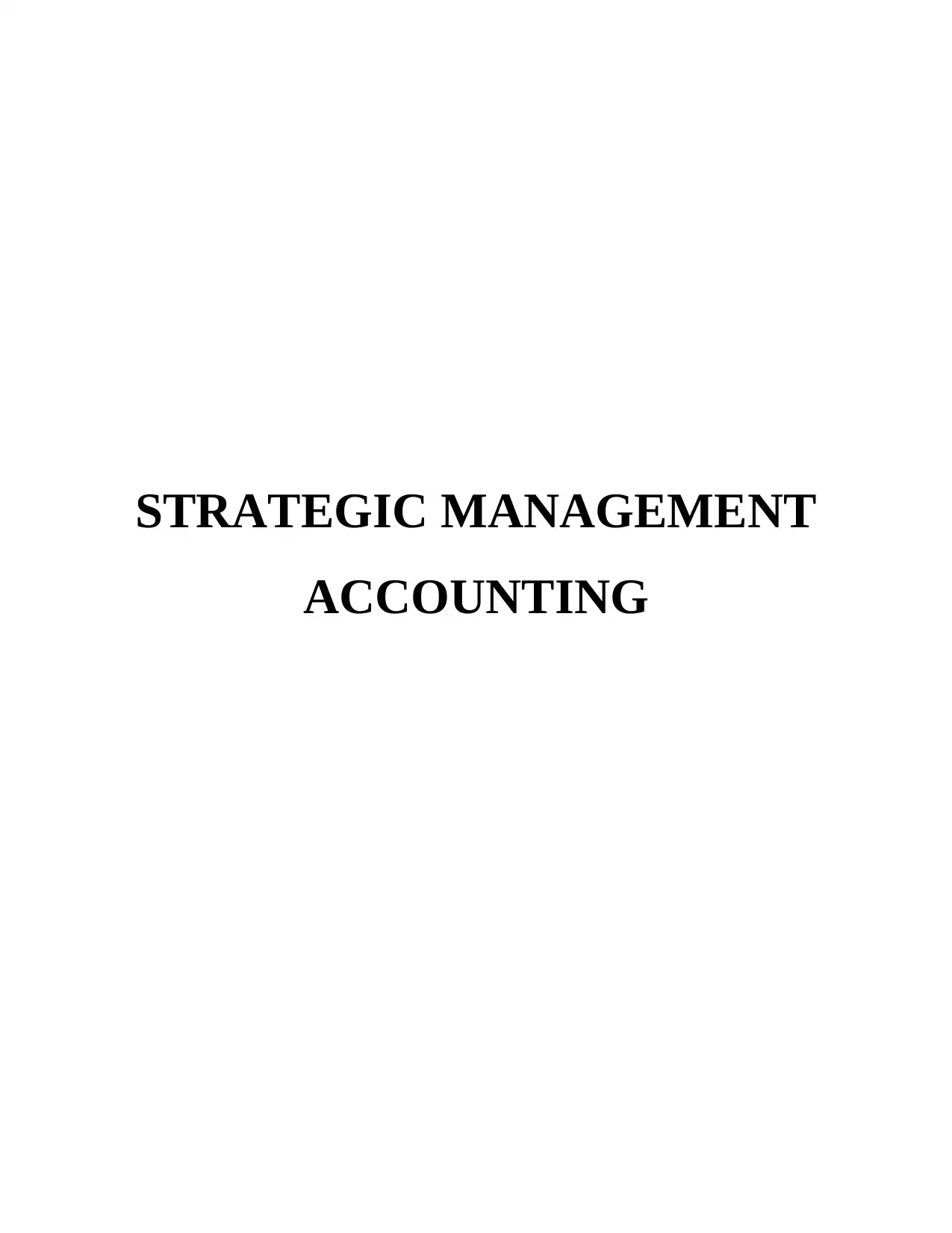
STRATEGIC MANAGEMENT
ACCOUNTING
ACCOUNTING
Paraphrase This Document
Need a fresh take? Get an instant paraphrase of this document with our AI Paraphraser
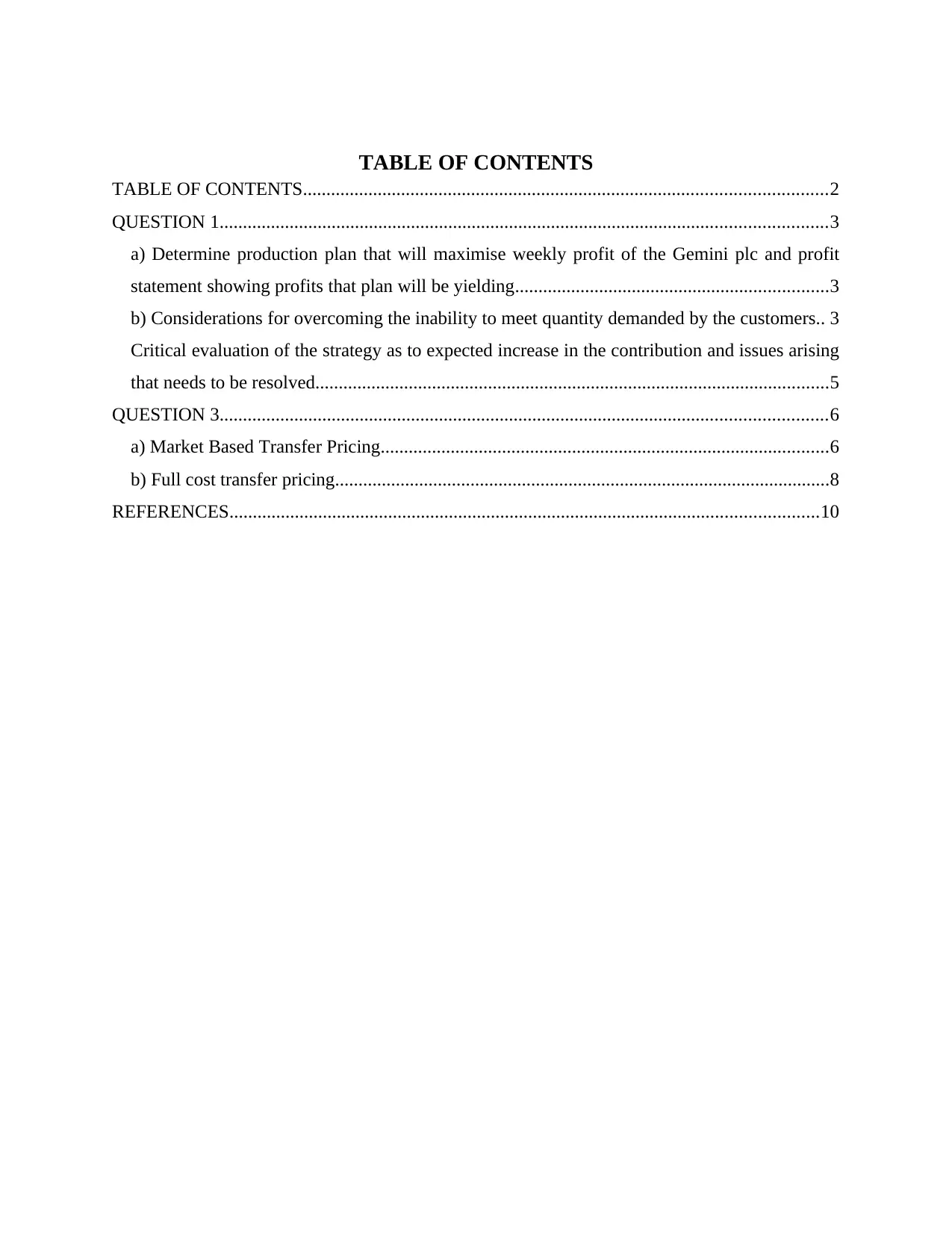
TABLE OF CONTENTS
TABLE OF CONTENTS................................................................................................................2
QUESTION 1..................................................................................................................................3
a) Determine production plan that will maximise weekly profit of the Gemini plc and profit
statement showing profits that plan will be yielding...................................................................3
b) Considerations for overcoming the inability to meet quantity demanded by the customers.. 3
Critical evaluation of the strategy as to expected increase in the contribution and issues arising
that needs to be resolved..............................................................................................................5
QUESTION 3..................................................................................................................................6
a) Market Based Transfer Pricing................................................................................................6
b) Full cost transfer pricing..........................................................................................................8
REFERENCES..............................................................................................................................10
TABLE OF CONTENTS................................................................................................................2
QUESTION 1..................................................................................................................................3
a) Determine production plan that will maximise weekly profit of the Gemini plc and profit
statement showing profits that plan will be yielding...................................................................3
b) Considerations for overcoming the inability to meet quantity demanded by the customers.. 3
Critical evaluation of the strategy as to expected increase in the contribution and issues arising
that needs to be resolved..............................................................................................................5
QUESTION 3..................................................................................................................................6
a) Market Based Transfer Pricing................................................................................................6
b) Full cost transfer pricing..........................................................................................................8
REFERENCES..............................................................................................................................10
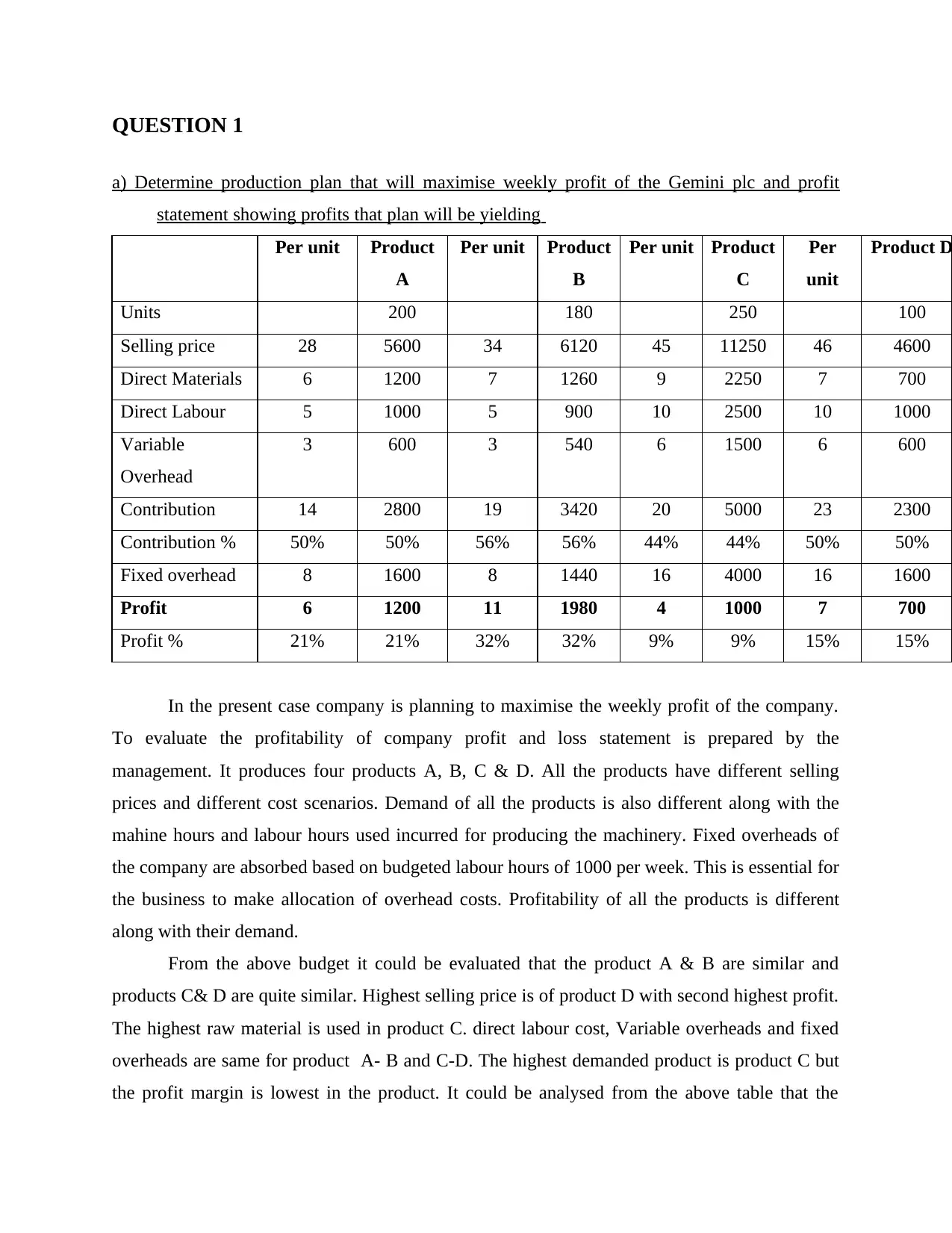
QUESTION 1
a) Determine production plan that will maximise weekly profit of the Gemini plc and profit
statement showing profits that plan will be yielding
Per unit Product
A
Per unit Product
B
Per unit Product
C
Per
unit
Product D
Units 200 180 250 100
Selling price 28 5600 34 6120 45 11250 46 4600
Direct Materials 6 1200 7 1260 9 2250 7 700
Direct Labour 5 1000 5 900 10 2500 10 1000
Variable
Overhead
3 600 3 540 6 1500 6 600
Contribution 14 2800 19 3420 20 5000 23 2300
Contribution % 50% 50% 56% 56% 44% 44% 50% 50%
Fixed overhead 8 1600 8 1440 16 4000 16 1600
Profit 6 1200 11 1980 4 1000 7 700
Profit % 21% 21% 32% 32% 9% 9% 15% 15%
In the present case company is planning to maximise the weekly profit of the company.
To evaluate the profitability of company profit and loss statement is prepared by the
management. It produces four products A, B, C & D. All the products have different selling
prices and different cost scenarios. Demand of all the products is also different along with the
mahine hours and labour hours used incurred for producing the machinery. Fixed overheads of
the company are absorbed based on budgeted labour hours of 1000 per week. This is essential for
the business to make allocation of overhead costs. Profitability of all the products is different
along with their demand.
From the above budget it could be evaluated that the product A & B are similar and
products C& D are quite similar. Highest selling price is of product D with second highest profit.
The highest raw material is used in product C. direct labour cost, Variable overheads and fixed
overheads are same for product A- B and C-D. The highest demanded product is product C but
the profit margin is lowest in the product. It could be analysed from the above table that the
a) Determine production plan that will maximise weekly profit of the Gemini plc and profit
statement showing profits that plan will be yielding
Per unit Product
A
Per unit Product
B
Per unit Product
C
Per
unit
Product D
Units 200 180 250 100
Selling price 28 5600 34 6120 45 11250 46 4600
Direct Materials 6 1200 7 1260 9 2250 7 700
Direct Labour 5 1000 5 900 10 2500 10 1000
Variable
Overhead
3 600 3 540 6 1500 6 600
Contribution 14 2800 19 3420 20 5000 23 2300
Contribution % 50% 50% 56% 56% 44% 44% 50% 50%
Fixed overhead 8 1600 8 1440 16 4000 16 1600
Profit 6 1200 11 1980 4 1000 7 700
Profit % 21% 21% 32% 32% 9% 9% 15% 15%
In the present case company is planning to maximise the weekly profit of the company.
To evaluate the profitability of company profit and loss statement is prepared by the
management. It produces four products A, B, C & D. All the products have different selling
prices and different cost scenarios. Demand of all the products is also different along with the
mahine hours and labour hours used incurred for producing the machinery. Fixed overheads of
the company are absorbed based on budgeted labour hours of 1000 per week. This is essential for
the business to make allocation of overhead costs. Profitability of all the products is different
along with their demand.
From the above budget it could be evaluated that the product A & B are similar and
products C& D are quite similar. Highest selling price is of product D with second highest profit.
The highest raw material is used in product C. direct labour cost, Variable overheads and fixed
overheads are same for product A- B and C-D. The highest demanded product is product C but
the profit margin is lowest in the product. It could be analysed from the above table that the
⊘ This is a preview!⊘
Do you want full access?
Subscribe today to unlock all pages.

Trusted by 1+ million students worldwide
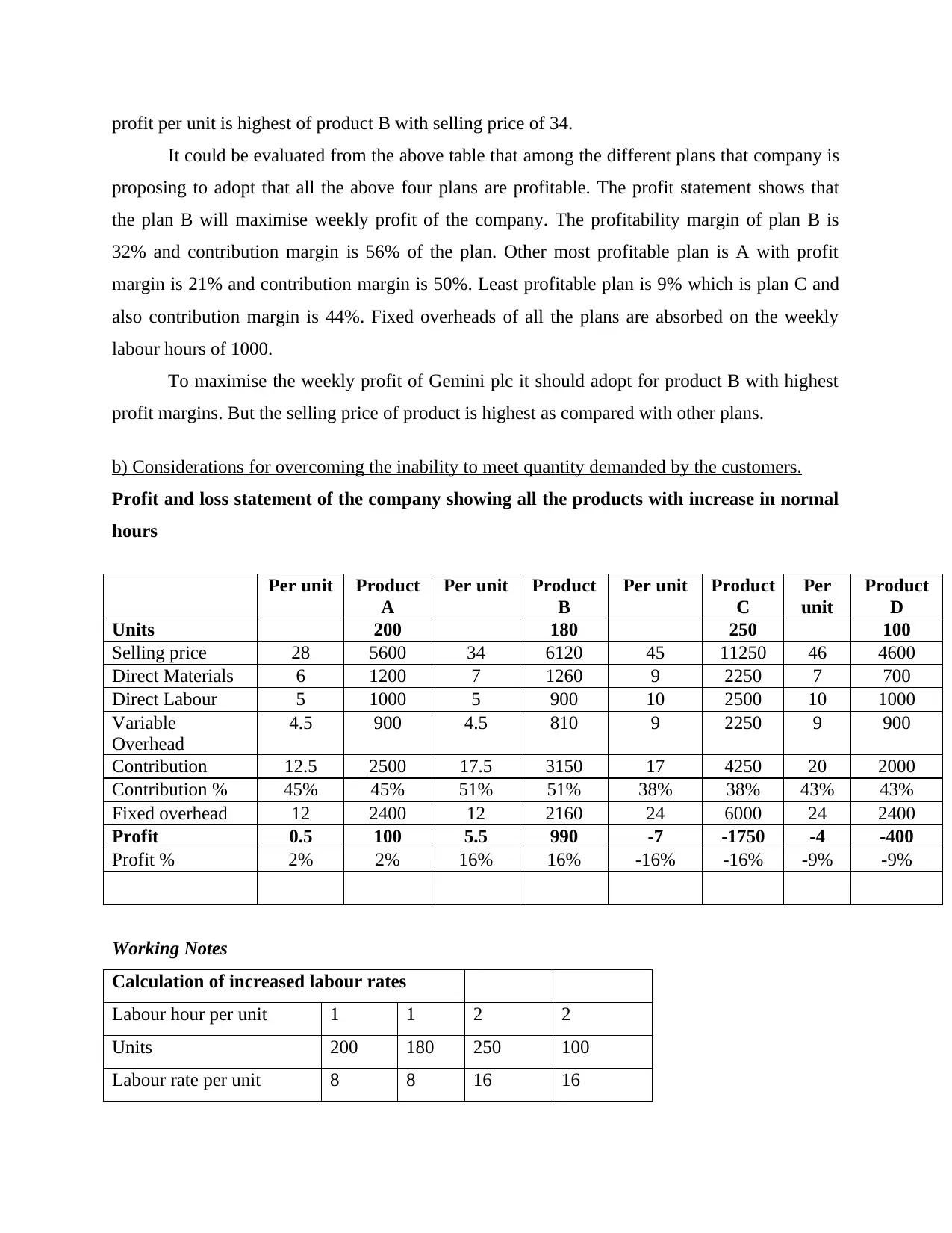
profit per unit is highest of product B with selling price of 34.
It could be evaluated from the above table that among the different plans that company is
proposing to adopt that all the above four plans are profitable. The profit statement shows that
the plan B will maximise weekly profit of the company. The profitability margin of plan B is
32% and contribution margin is 56% of the plan. Other most profitable plan is A with profit
margin is 21% and contribution margin is 50%. Least profitable plan is 9% which is plan C and
also contribution margin is 44%. Fixed overheads of all the plans are absorbed on the weekly
labour hours of 1000.
To maximise the weekly profit of Gemini plc it should adopt for product B with highest
profit margins. But the selling price of product is highest as compared with other plans.
b) Considerations for overcoming the inability to meet quantity demanded by the customers.
Profit and loss statement of the company showing all the products with increase in normal
hours
Per unit Product
A
Per unit Product
B
Per unit Product
C
Per
unit
Product
D
Units 200 180 250 100
Selling price 28 5600 34 6120 45 11250 46 4600
Direct Materials 6 1200 7 1260 9 2250 7 700
Direct Labour 5 1000 5 900 10 2500 10 1000
Variable
Overhead
4.5 900 4.5 810 9 2250 9 900
Contribution 12.5 2500 17.5 3150 17 4250 20 2000
Contribution % 45% 45% 51% 51% 38% 38% 43% 43%
Fixed overhead 12 2400 12 2160 24 6000 24 2400
Profit 0.5 100 5.5 990 -7 -1750 -4 -400
Profit % 2% 2% 16% 16% -16% -16% -9% -9%
Working Notes
Calculation of increased labour rates
Labour hour per unit 1 1 2 2
Units 200 180 250 100
Labour rate per unit 8 8 16 16
It could be evaluated from the above table that among the different plans that company is
proposing to adopt that all the above four plans are profitable. The profit statement shows that
the plan B will maximise weekly profit of the company. The profitability margin of plan B is
32% and contribution margin is 56% of the plan. Other most profitable plan is A with profit
margin is 21% and contribution margin is 50%. Least profitable plan is 9% which is plan C and
also contribution margin is 44%. Fixed overheads of all the plans are absorbed on the weekly
labour hours of 1000.
To maximise the weekly profit of Gemini plc it should adopt for product B with highest
profit margins. But the selling price of product is highest as compared with other plans.
b) Considerations for overcoming the inability to meet quantity demanded by the customers.
Profit and loss statement of the company showing all the products with increase in normal
hours
Per unit Product
A
Per unit Product
B
Per unit Product
C
Per
unit
Product
D
Units 200 180 250 100
Selling price 28 5600 34 6120 45 11250 46 4600
Direct Materials 6 1200 7 1260 9 2250 7 700
Direct Labour 5 1000 5 900 10 2500 10 1000
Variable
Overhead
4.5 900 4.5 810 9 2250 9 900
Contribution 12.5 2500 17.5 3150 17 4250 20 2000
Contribution % 45% 45% 51% 51% 38% 38% 43% 43%
Fixed overhead 12 2400 12 2160 24 6000 24 2400
Profit 0.5 100 5.5 990 -7 -1750 -4 -400
Profit % 2% 2% 16% 16% -16% -16% -9% -9%
Working Notes
Calculation of increased labour rates
Labour hour per unit 1 1 2 2
Units 200 180 250 100
Labour rate per unit 8 8 16 16
Paraphrase This Document
Need a fresh take? Get an instant paraphrase of this document with our AI Paraphraser

Increase in labour rates
50%
12 12 24 24
Calculation of variable overheads 50%
Variable overheads 3 3 6 6
Increase 50% 4.5 4.5 9 9
As the company is unable to meet quantity demanded by the customers and for overcoming
the increase in number of hours worked using existing machinery by the working overtime.
Company is proposing to pay the overtime at premium of 50% above the normal labour rates.
According it proposes that variable overheads of the company would be also increasing in
proportion to the labour costs. To resolve the issues company has taken the step for raising the
time worked on machines. It could be analysed that on increasing the labour cost for overtime
cost the rate will increase to 12 for products A and B and 24 per unit for product C & D with
highest selling prices. The labour hours used are also highest in the product c &d. Increasing the
labour rate has declined the profit margins significantly as the available cost have raised along
with the labour of the company.
It could be evaluated that increase in labour rate due to the overtime will reduce the profit
margins of plans considerably. Due to the overtime company has to pay labour rate at 50%
which increases the labour rate and also the variable cost will be increased in proportion of
labour costs. Only plan that remains profitable after the increase in labour cost is Product B.
However the profit margins are reduced from 32% to 16%. While other products plan have gone
negative due to increase in labour cost and variable overheads. Hence if the company increases
the labour rate for overtime the profit magins will be declined significantly and also the products
C & D will become loss making as company would not be able to cover the cost at existing price
of the products.
Critical evaluation of the strategy as to expected increase in the contribution and issues arising
that needs to be resolved.
In current case Gemini plc is manufacturing four products using same machinery. Fixed
overheads are absorbed on budgeted labour hours of company and the maximum capacity of
50%
12 12 24 24
Calculation of variable overheads 50%
Variable overheads 3 3 6 6
Increase 50% 4.5 4.5 9 9
As the company is unable to meet quantity demanded by the customers and for overcoming
the increase in number of hours worked using existing machinery by the working overtime.
Company is proposing to pay the overtime at premium of 50% above the normal labour rates.
According it proposes that variable overheads of the company would be also increasing in
proportion to the labour costs. To resolve the issues company has taken the step for raising the
time worked on machines. It could be analysed that on increasing the labour cost for overtime
cost the rate will increase to 12 for products A and B and 24 per unit for product C & D with
highest selling prices. The labour hours used are also highest in the product c &d. Increasing the
labour rate has declined the profit margins significantly as the available cost have raised along
with the labour of the company.
It could be evaluated that increase in labour rate due to the overtime will reduce the profit
margins of plans considerably. Due to the overtime company has to pay labour rate at 50%
which increases the labour rate and also the variable cost will be increased in proportion of
labour costs. Only plan that remains profitable after the increase in labour cost is Product B.
However the profit margins are reduced from 32% to 16%. While other products plan have gone
negative due to increase in labour cost and variable overheads. Hence if the company increases
the labour rate for overtime the profit magins will be declined significantly and also the products
C & D will become loss making as company would not be able to cover the cost at existing price
of the products.
Critical evaluation of the strategy as to expected increase in the contribution and issues arising
that needs to be resolved.
In current case Gemini plc is manufacturing four products using same machinery. Fixed
overheads are absorbed on budgeted labour hours of company and the maximum capacity of
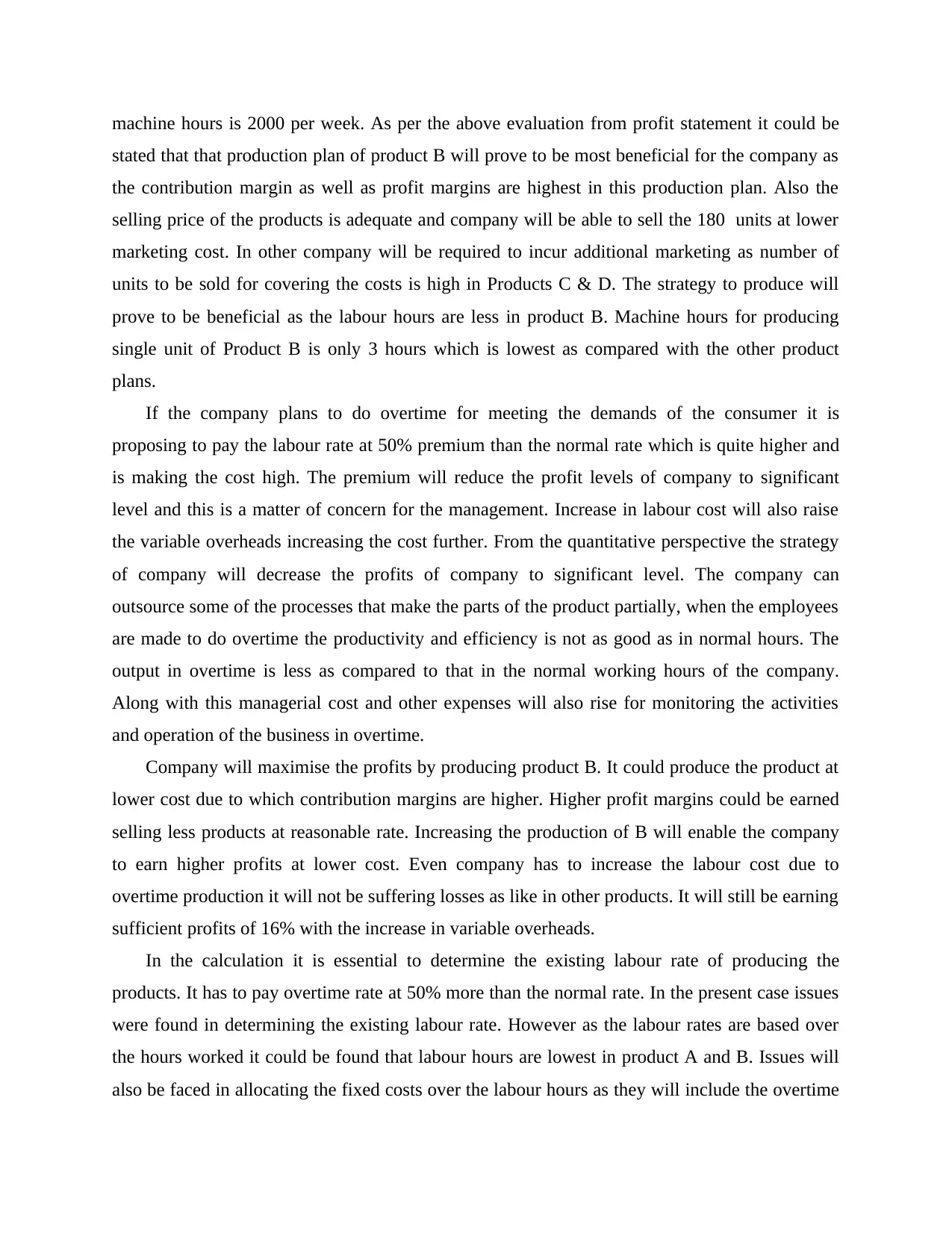
machine hours is 2000 per week. As per the above evaluation from profit statement it could be
stated that that production plan of product B will prove to be most beneficial for the company as
the contribution margin as well as profit margins are highest in this production plan. Also the
selling price of the products is adequate and company will be able to sell the 180 units at lower
marketing cost. In other company will be required to incur additional marketing as number of
units to be sold for covering the costs is high in Products C & D. The strategy to produce will
prove to be beneficial as the labour hours are less in product B. Machine hours for producing
single unit of Product B is only 3 hours which is lowest as compared with the other product
plans.
If the company plans to do overtime for meeting the demands of the consumer it is
proposing to pay the labour rate at 50% premium than the normal rate which is quite higher and
is making the cost high. The premium will reduce the profit levels of company to significant
level and this is a matter of concern for the management. Increase in labour cost will also raise
the variable overheads increasing the cost further. From the quantitative perspective the strategy
of company will decrease the profits of company to significant level. The company can
outsource some of the processes that make the parts of the product partially, when the employees
are made to do overtime the productivity and efficiency is not as good as in normal hours. The
output in overtime is less as compared to that in the normal working hours of the company.
Along with this managerial cost and other expenses will also rise for monitoring the activities
and operation of the business in overtime.
Company will maximise the profits by producing product B. It could produce the product at
lower cost due to which contribution margins are higher. Higher profit margins could be earned
selling less products at reasonable rate. Increasing the production of B will enable the company
to earn higher profits at lower cost. Even company has to increase the labour cost due to
overtime production it will not be suffering losses as like in other products. It will still be earning
sufficient profits of 16% with the increase in variable overheads.
In the calculation it is essential to determine the existing labour rate of producing the
products. It has to pay overtime rate at 50% more than the normal rate. In the present case issues
were found in determining the existing labour rate. However as the labour rates are based over
the hours worked it could be found that labour hours are lowest in product A and B. Issues will
also be faced in allocating the fixed costs over the labour hours as they will include the overtime
stated that that production plan of product B will prove to be most beneficial for the company as
the contribution margin as well as profit margins are highest in this production plan. Also the
selling price of the products is adequate and company will be able to sell the 180 units at lower
marketing cost. In other company will be required to incur additional marketing as number of
units to be sold for covering the costs is high in Products C & D. The strategy to produce will
prove to be beneficial as the labour hours are less in product B. Machine hours for producing
single unit of Product B is only 3 hours which is lowest as compared with the other product
plans.
If the company plans to do overtime for meeting the demands of the consumer it is
proposing to pay the labour rate at 50% premium than the normal rate which is quite higher and
is making the cost high. The premium will reduce the profit levels of company to significant
level and this is a matter of concern for the management. Increase in labour cost will also raise
the variable overheads increasing the cost further. From the quantitative perspective the strategy
of company will decrease the profits of company to significant level. The company can
outsource some of the processes that make the parts of the product partially, when the employees
are made to do overtime the productivity and efficiency is not as good as in normal hours. The
output in overtime is less as compared to that in the normal working hours of the company.
Along with this managerial cost and other expenses will also rise for monitoring the activities
and operation of the business in overtime.
Company will maximise the profits by producing product B. It could produce the product at
lower cost due to which contribution margins are higher. Higher profit margins could be earned
selling less products at reasonable rate. Increasing the production of B will enable the company
to earn higher profits at lower cost. Even company has to increase the labour cost due to
overtime production it will not be suffering losses as like in other products. It will still be earning
sufficient profits of 16% with the increase in variable overheads.
In the calculation it is essential to determine the existing labour rate of producing the
products. It has to pay overtime rate at 50% more than the normal rate. In the present case issues
were found in determining the existing labour rate. However as the labour rates are based over
the hours worked it could be found that labour hours are lowest in product A and B. Issues will
also be faced in allocating the fixed costs over the labour hours as they will include the overtime
⊘ This is a preview!⊘
Do you want full access?
Subscribe today to unlock all pages.

Trusted by 1+ million students worldwide
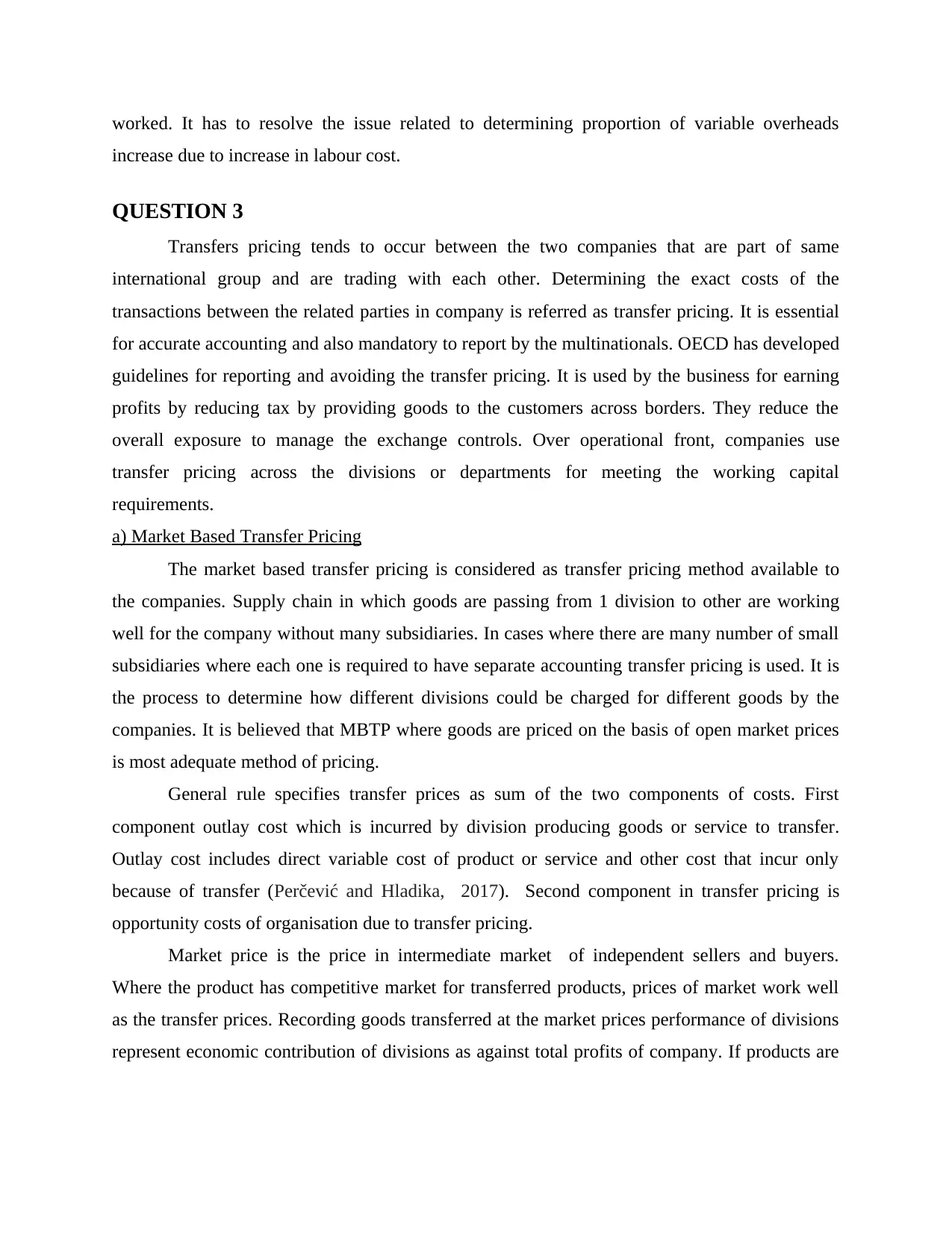
worked. It has to resolve the issue related to determining proportion of variable overheads
increase due to increase in labour cost.
QUESTION 3
Transfers pricing tends to occur between the two companies that are part of same
international group and are trading with each other. Determining the exact costs of the
transactions between the related parties in company is referred as transfer pricing. It is essential
for accurate accounting and also mandatory to report by the multinationals. OECD has developed
guidelines for reporting and avoiding the transfer pricing. It is used by the business for earning
profits by reducing tax by providing goods to the customers across borders. They reduce the
overall exposure to manage the exchange controls. Over operational front, companies use
transfer pricing across the divisions or departments for meeting the working capital
requirements.
a) Market Based Transfer Pricing
The market based transfer pricing is considered as transfer pricing method available to
the companies. Supply chain in which goods are passing from 1 division to other are working
well for the company without many subsidiaries. In cases where there are many number of small
subsidiaries where each one is required to have separate accounting transfer pricing is used. It is
the process to determine how different divisions could be charged for different goods by the
companies. It is believed that MBTP where goods are priced on the basis of open market prices
is most adequate method of pricing.
General rule specifies transfer prices as sum of the two components of costs. First
component outlay cost which is incurred by division producing goods or service to transfer.
Outlay cost includes direct variable cost of product or service and other cost that incur only
because of transfer (Perčević and Hladika, 2017). Second component in transfer pricing is
opportunity costs of organisation due to transfer pricing.
Market price is the price in intermediate market of independent sellers and buyers.
Where the product has competitive market for transferred products, prices of market work well
as the transfer prices. Recording goods transferred at the market prices performance of divisions
represent economic contribution of divisions as against total profits of company. If products are
increase due to increase in labour cost.
QUESTION 3
Transfers pricing tends to occur between the two companies that are part of same
international group and are trading with each other. Determining the exact costs of the
transactions between the related parties in company is referred as transfer pricing. It is essential
for accurate accounting and also mandatory to report by the multinationals. OECD has developed
guidelines for reporting and avoiding the transfer pricing. It is used by the business for earning
profits by reducing tax by providing goods to the customers across borders. They reduce the
overall exposure to manage the exchange controls. Over operational front, companies use
transfer pricing across the divisions or departments for meeting the working capital
requirements.
a) Market Based Transfer Pricing
The market based transfer pricing is considered as transfer pricing method available to
the companies. Supply chain in which goods are passing from 1 division to other are working
well for the company without many subsidiaries. In cases where there are many number of small
subsidiaries where each one is required to have separate accounting transfer pricing is used. It is
the process to determine how different divisions could be charged for different goods by the
companies. It is believed that MBTP where goods are priced on the basis of open market prices
is most adequate method of pricing.
General rule specifies transfer prices as sum of the two components of costs. First
component outlay cost which is incurred by division producing goods or service to transfer.
Outlay cost includes direct variable cost of product or service and other cost that incur only
because of transfer (Perčević and Hladika, 2017). Second component in transfer pricing is
opportunity costs of organisation due to transfer pricing.
Market price is the price in intermediate market of independent sellers and buyers.
Where the product has competitive market for transferred products, prices of market work well
as the transfer prices. Recording goods transferred at the market prices performance of divisions
represent economic contribution of divisions as against total profits of company. If products are
Paraphrase This Document
Need a fresh take? Get an instant paraphrase of this document with our AI Paraphraser
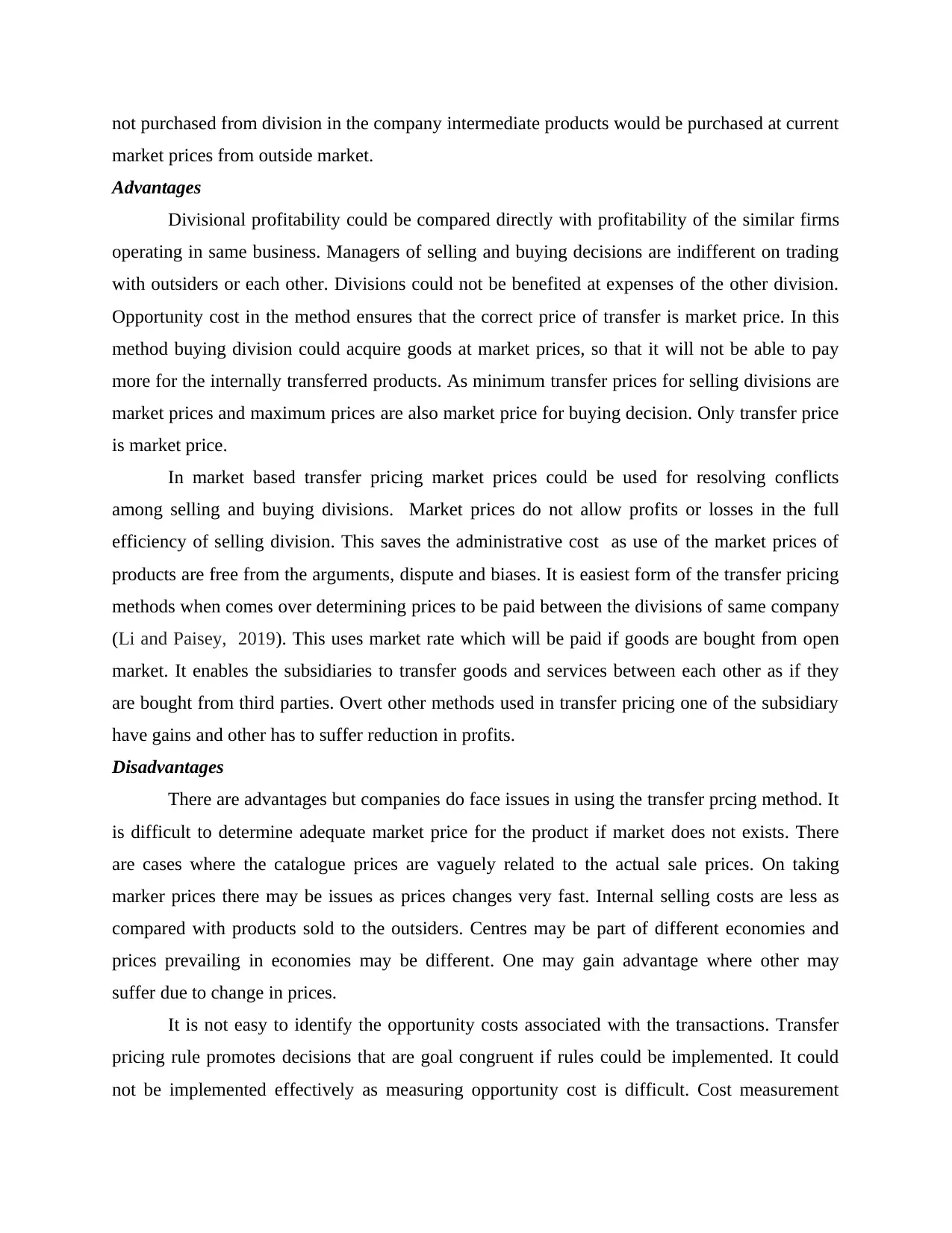
not purchased from division in the company intermediate products would be purchased at current
market prices from outside market.
Advantages
Divisional profitability could be compared directly with profitability of the similar firms
operating in same business. Managers of selling and buying decisions are indifferent on trading
with outsiders or each other. Divisions could not be benefited at expenses of the other division.
Opportunity cost in the method ensures that the correct price of transfer is market price. In this
method buying division could acquire goods at market prices, so that it will not be able to pay
more for the internally transferred products. As minimum transfer prices for selling divisions are
market prices and maximum prices are also market price for buying decision. Only transfer price
is market price.
In market based transfer pricing market prices could be used for resolving conflicts
among selling and buying divisions. Market prices do not allow profits or losses in the full
efficiency of selling division. This saves the administrative cost as use of the market prices of
products are free from the arguments, dispute and biases. It is easiest form of the transfer pricing
methods when comes over determining prices to be paid between the divisions of same company
(Li and Paisey, 2019). This uses market rate which will be paid if goods are bought from open
market. It enables the subsidiaries to transfer goods and services between each other as if they
are bought from third parties. Overt other methods used in transfer pricing one of the subsidiary
have gains and other has to suffer reduction in profits.
Disadvantages
There are advantages but companies do face issues in using the transfer prcing method. It
is difficult to determine adequate market price for the product if market does not exists. There
are cases where the catalogue prices are vaguely related to the actual sale prices. On taking
marker prices there may be issues as prices changes very fast. Internal selling costs are less as
compared with products sold to the outsiders. Centres may be part of different economies and
prices prevailing in economies may be different. One may gain advantage where other may
suffer due to change in prices.
It is not easy to identify the opportunity costs associated with the transactions. Transfer
pricing rule promotes decisions that are goal congruent if rules could be implemented. It could
not be implemented effectively as measuring opportunity cost is difficult. Cost measurement
market prices from outside market.
Advantages
Divisional profitability could be compared directly with profitability of the similar firms
operating in same business. Managers of selling and buying decisions are indifferent on trading
with outsiders or each other. Divisions could not be benefited at expenses of the other division.
Opportunity cost in the method ensures that the correct price of transfer is market price. In this
method buying division could acquire goods at market prices, so that it will not be able to pay
more for the internally transferred products. As minimum transfer prices for selling divisions are
market prices and maximum prices are also market price for buying decision. Only transfer price
is market price.
In market based transfer pricing market prices could be used for resolving conflicts
among selling and buying divisions. Market prices do not allow profits or losses in the full
efficiency of selling division. This saves the administrative cost as use of the market prices of
products are free from the arguments, dispute and biases. It is easiest form of the transfer pricing
methods when comes over determining prices to be paid between the divisions of same company
(Li and Paisey, 2019). This uses market rate which will be paid if goods are bought from open
market. It enables the subsidiaries to transfer goods and services between each other as if they
are bought from third parties. Overt other methods used in transfer pricing one of the subsidiary
have gains and other has to suffer reduction in profits.
Disadvantages
There are advantages but companies do face issues in using the transfer prcing method. It
is difficult to determine adequate market price for the product if market does not exists. There
are cases where the catalogue prices are vaguely related to the actual sale prices. On taking
marker prices there may be issues as prices changes very fast. Internal selling costs are less as
compared with products sold to the outsiders. Centres may be part of different economies and
prices prevailing in economies may be different. One may gain advantage where other may
suffer due to change in prices.
It is not easy to identify the opportunity costs associated with the transactions. Transfer
pricing rule promotes decisions that are goal congruent if rules could be implemented. It could
not be implemented effectively as measuring opportunity cost is difficult. Cost measurement
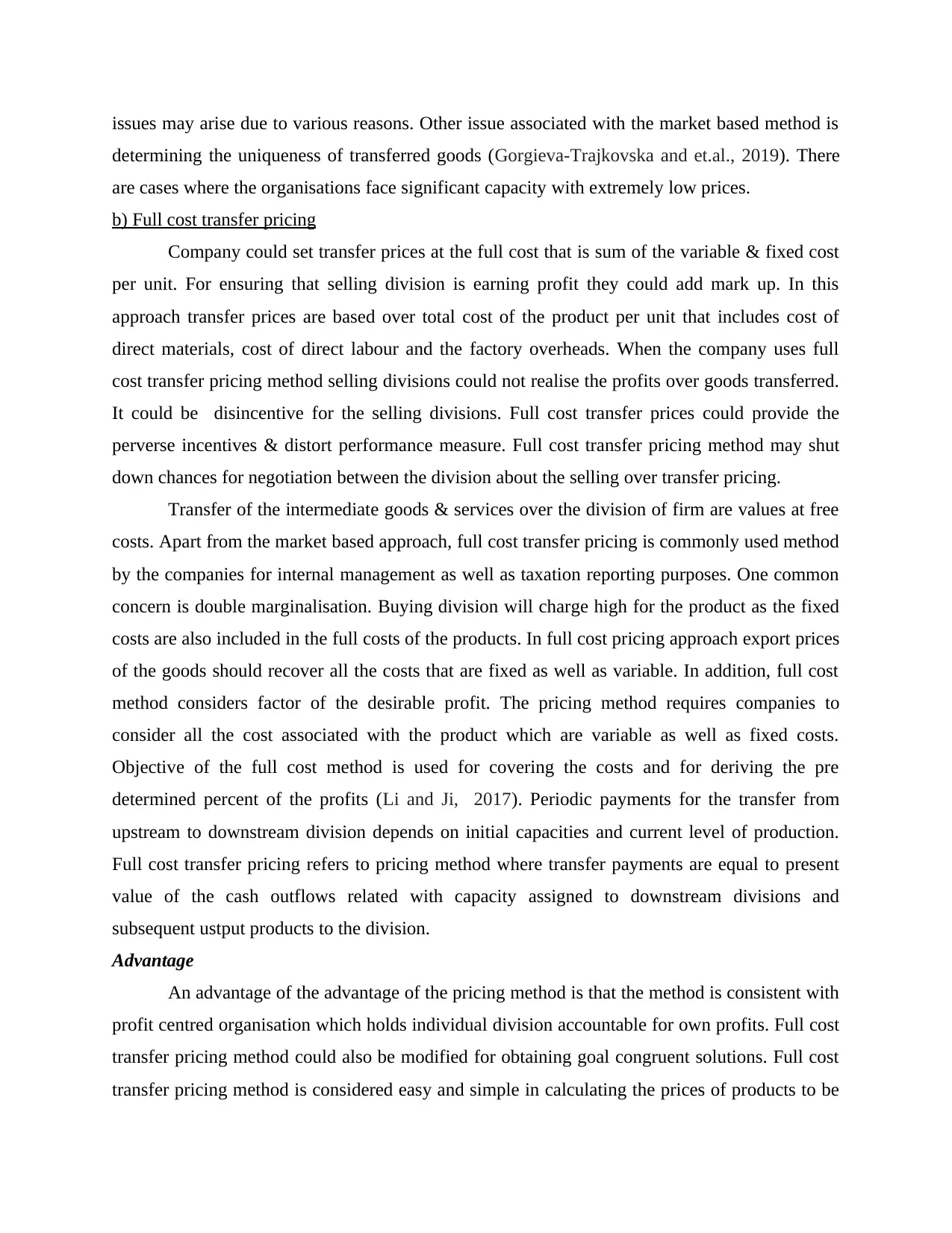
issues may arise due to various reasons. Other issue associated with the market based method is
determining the uniqueness of transferred goods (Gorgieva-Trajkovska and et.al., 2019). There
are cases where the organisations face significant capacity with extremely low prices.
b) Full cost transfer pricing
Company could set transfer prices at the full cost that is sum of the variable & fixed cost
per unit. For ensuring that selling division is earning profit they could add mark up. In this
approach transfer prices are based over total cost of the product per unit that includes cost of
direct materials, cost of direct labour and the factory overheads. When the company uses full
cost transfer pricing method selling divisions could not realise the profits over goods transferred.
It could be disincentive for the selling divisions. Full cost transfer prices could provide the
perverse incentives & distort performance measure. Full cost transfer pricing method may shut
down chances for negotiation between the division about the selling over transfer pricing.
Transfer of the intermediate goods & services over the division of firm are values at free
costs. Apart from the market based approach, full cost transfer pricing is commonly used method
by the companies for internal management as well as taxation reporting purposes. One common
concern is double marginalisation. Buying division will charge high for the product as the fixed
costs are also included in the full costs of the products. In full cost pricing approach export prices
of the goods should recover all the costs that are fixed as well as variable. In addition, full cost
method considers factor of the desirable profit. The pricing method requires companies to
consider all the cost associated with the product which are variable as well as fixed costs.
Objective of the full cost method is used for covering the costs and for deriving the pre
determined percent of the profits (Li and Ji, 2017). Periodic payments for the transfer from
upstream to downstream division depends on initial capacities and current level of production.
Full cost transfer pricing refers to pricing method where transfer payments are equal to present
value of the cash outflows related with capacity assigned to downstream divisions and
subsequent ustput products to the division.
Advantage
An advantage of the advantage of the pricing method is that the method is consistent with
profit centred organisation which holds individual division accountable for own profits. Full cost
transfer pricing method could also be modified for obtaining goal congruent solutions. Full cost
transfer pricing method is considered easy and simple in calculating the prices of products to be
determining the uniqueness of transferred goods (Gorgieva-Trajkovska and et.al., 2019). There
are cases where the organisations face significant capacity with extremely low prices.
b) Full cost transfer pricing
Company could set transfer prices at the full cost that is sum of the variable & fixed cost
per unit. For ensuring that selling division is earning profit they could add mark up. In this
approach transfer prices are based over total cost of the product per unit that includes cost of
direct materials, cost of direct labour and the factory overheads. When the company uses full
cost transfer pricing method selling divisions could not realise the profits over goods transferred.
It could be disincentive for the selling divisions. Full cost transfer prices could provide the
perverse incentives & distort performance measure. Full cost transfer pricing method may shut
down chances for negotiation between the division about the selling over transfer pricing.
Transfer of the intermediate goods & services over the division of firm are values at free
costs. Apart from the market based approach, full cost transfer pricing is commonly used method
by the companies for internal management as well as taxation reporting purposes. One common
concern is double marginalisation. Buying division will charge high for the product as the fixed
costs are also included in the full costs of the products. In full cost pricing approach export prices
of the goods should recover all the costs that are fixed as well as variable. In addition, full cost
method considers factor of the desirable profit. The pricing method requires companies to
consider all the cost associated with the product which are variable as well as fixed costs.
Objective of the full cost method is used for covering the costs and for deriving the pre
determined percent of the profits (Li and Ji, 2017). Periodic payments for the transfer from
upstream to downstream division depends on initial capacities and current level of production.
Full cost transfer pricing refers to pricing method where transfer payments are equal to present
value of the cash outflows related with capacity assigned to downstream divisions and
subsequent ustput products to the division.
Advantage
An advantage of the advantage of the pricing method is that the method is consistent with
profit centred organisation which holds individual division accountable for own profits. Full cost
transfer pricing method could also be modified for obtaining goal congruent solutions. Full cost
transfer pricing method is considered easy and simple in calculating the prices of products to be
⊘ This is a preview!⊘
Do you want full access?
Subscribe today to unlock all pages.

Trusted by 1+ million students worldwide
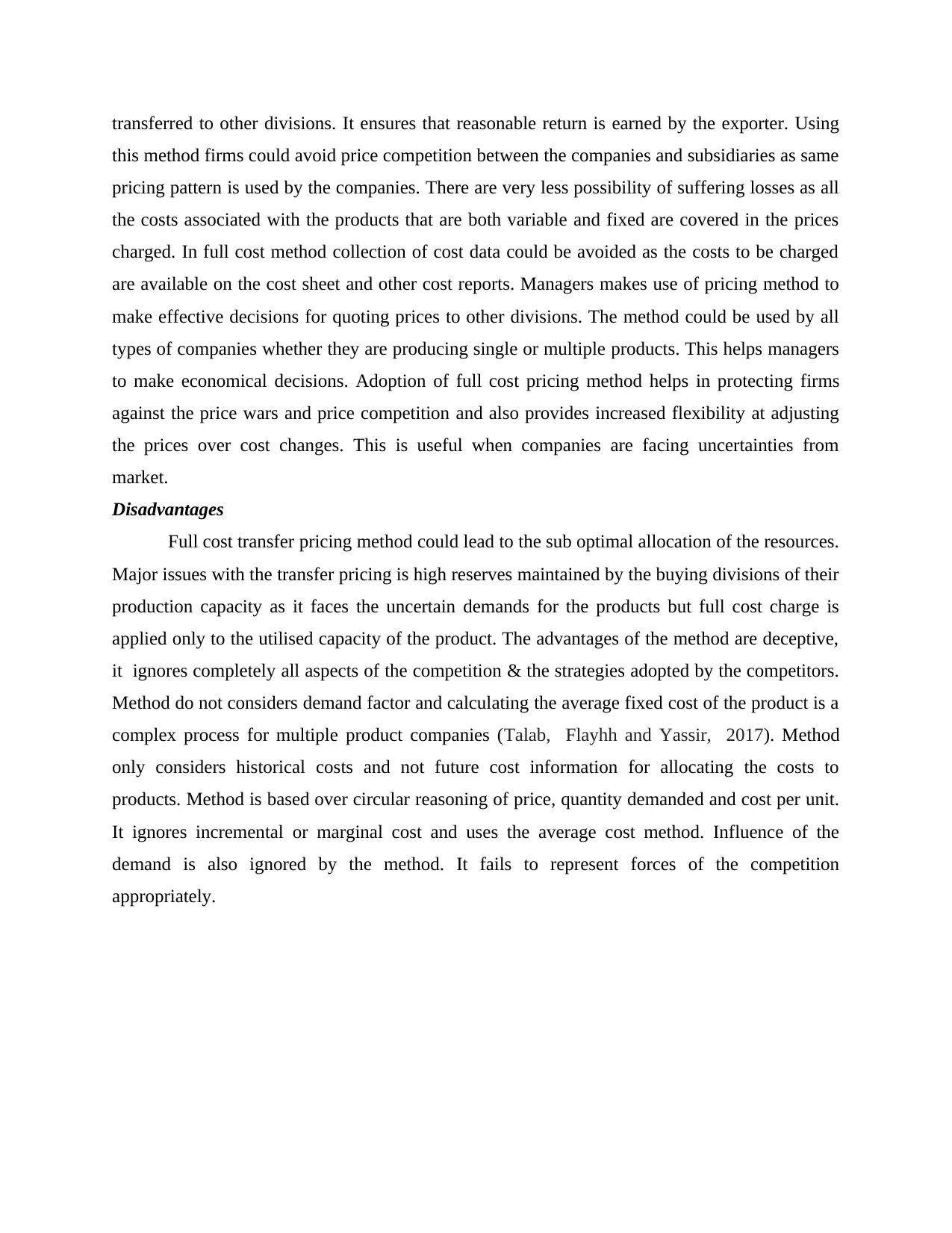
transferred to other divisions. It ensures that reasonable return is earned by the exporter. Using
this method firms could avoid price competition between the companies and subsidiaries as same
pricing pattern is used by the companies. There are very less possibility of suffering losses as all
the costs associated with the products that are both variable and fixed are covered in the prices
charged. In full cost method collection of cost data could be avoided as the costs to be charged
are available on the cost sheet and other cost reports. Managers makes use of pricing method to
make effective decisions for quoting prices to other divisions. The method could be used by all
types of companies whether they are producing single or multiple products. This helps managers
to make economical decisions. Adoption of full cost pricing method helps in protecting firms
against the price wars and price competition and also provides increased flexibility at adjusting
the prices over cost changes. This is useful when companies are facing uncertainties from
market.
Disadvantages
Full cost transfer pricing method could lead to the sub optimal allocation of the resources.
Major issues with the transfer pricing is high reserves maintained by the buying divisions of their
production capacity as it faces the uncertain demands for the products but full cost charge is
applied only to the utilised capacity of the product. The advantages of the method are deceptive,
it ignores completely all aspects of the competition & the strategies adopted by the competitors.
Method do not considers demand factor and calculating the average fixed cost of the product is a
complex process for multiple product companies (Talab, Flayhh and Yassir, 2017). Method
only considers historical costs and not future cost information for allocating the costs to
products. Method is based over circular reasoning of price, quantity demanded and cost per unit.
It ignores incremental or marginal cost and uses the average cost method. Influence of the
demand is also ignored by the method. It fails to represent forces of the competition
appropriately.
this method firms could avoid price competition between the companies and subsidiaries as same
pricing pattern is used by the companies. There are very less possibility of suffering losses as all
the costs associated with the products that are both variable and fixed are covered in the prices
charged. In full cost method collection of cost data could be avoided as the costs to be charged
are available on the cost sheet and other cost reports. Managers makes use of pricing method to
make effective decisions for quoting prices to other divisions. The method could be used by all
types of companies whether they are producing single or multiple products. This helps managers
to make economical decisions. Adoption of full cost pricing method helps in protecting firms
against the price wars and price competition and also provides increased flexibility at adjusting
the prices over cost changes. This is useful when companies are facing uncertainties from
market.
Disadvantages
Full cost transfer pricing method could lead to the sub optimal allocation of the resources.
Major issues with the transfer pricing is high reserves maintained by the buying divisions of their
production capacity as it faces the uncertain demands for the products but full cost charge is
applied only to the utilised capacity of the product. The advantages of the method are deceptive,
it ignores completely all aspects of the competition & the strategies adopted by the competitors.
Method do not considers demand factor and calculating the average fixed cost of the product is a
complex process for multiple product companies (Talab, Flayhh and Yassir, 2017). Method
only considers historical costs and not future cost information for allocating the costs to
products. Method is based over circular reasoning of price, quantity demanded and cost per unit.
It ignores incremental or marginal cost and uses the average cost method. Influence of the
demand is also ignored by the method. It fails to represent forces of the competition
appropriately.
Paraphrase This Document
Need a fresh take? Get an instant paraphrase of this document with our AI Paraphraser
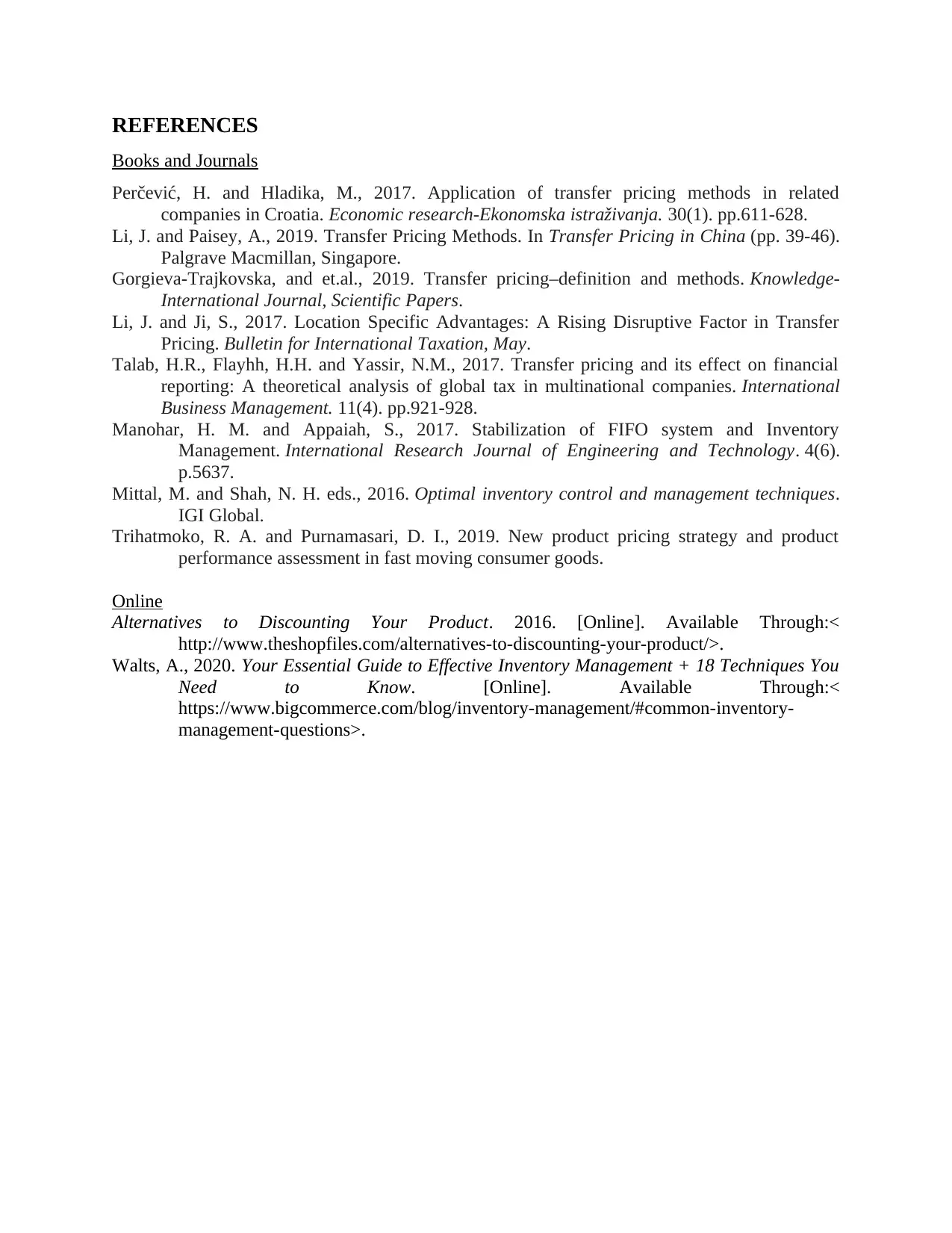
REFERENCES
Books and Journals
Perčević, H. and Hladika, M., 2017. Application of transfer pricing methods in related
companies in Croatia. Economic research-Ekonomska istraživanja. 30(1). pp.611-628.
Li, J. and Paisey, A., 2019. Transfer Pricing Methods. In Transfer Pricing in China (pp. 39-46).
Palgrave Macmillan, Singapore.
Gorgieva-Trajkovska, and et.al., 2019. Transfer pricing–definition and methods. Knowledge-
International Journal, Scientific Papers.
Li, J. and Ji, S., 2017. Location Specific Advantages: A Rising Disruptive Factor in Transfer
Pricing. Bulletin for International Taxation, May.
Talab, H.R., Flayhh, H.H. and Yassir, N.M., 2017. Transfer pricing and its effect on financial
reporting: A theoretical analysis of global tax in multinational companies. International
Business Management. 11(4). pp.921-928.
Manohar, H. M. and Appaiah, S., 2017. Stabilization of FIFO system and Inventory
Management. International Research Journal of Engineering and Technology. 4(6).
p.5637.
Mittal, M. and Shah, N. H. eds., 2016. Optimal inventory control and management techniques.
IGI Global.
Trihatmoko, R. A. and Purnamasari, D. I., 2019. New product pricing strategy and product
performance assessment in fast moving consumer goods.
Online
Alternatives to Discounting Your Product. 2016. [Online]. Available Through:<
http://www.theshopfiles.com/alternatives-to-discounting-your-product/>.
Walts, A., 2020. Your Essential Guide to Effective Inventory Management + 18 Techniques You
Need to Know. [Online]. Available Through:<
https://www.bigcommerce.com/blog/inventory-management/#common-inventory-
management-questions>.
Books and Journals
Perčević, H. and Hladika, M., 2017. Application of transfer pricing methods in related
companies in Croatia. Economic research-Ekonomska istraživanja. 30(1). pp.611-628.
Li, J. and Paisey, A., 2019. Transfer Pricing Methods. In Transfer Pricing in China (pp. 39-46).
Palgrave Macmillan, Singapore.
Gorgieva-Trajkovska, and et.al., 2019. Transfer pricing–definition and methods. Knowledge-
International Journal, Scientific Papers.
Li, J. and Ji, S., 2017. Location Specific Advantages: A Rising Disruptive Factor in Transfer
Pricing. Bulletin for International Taxation, May.
Talab, H.R., Flayhh, H.H. and Yassir, N.M., 2017. Transfer pricing and its effect on financial
reporting: A theoretical analysis of global tax in multinational companies. International
Business Management. 11(4). pp.921-928.
Manohar, H. M. and Appaiah, S., 2017. Stabilization of FIFO system and Inventory
Management. International Research Journal of Engineering and Technology. 4(6).
p.5637.
Mittal, M. and Shah, N. H. eds., 2016. Optimal inventory control and management techniques.
IGI Global.
Trihatmoko, R. A. and Purnamasari, D. I., 2019. New product pricing strategy and product
performance assessment in fast moving consumer goods.
Online
Alternatives to Discounting Your Product. 2016. [Online]. Available Through:<
http://www.theshopfiles.com/alternatives-to-discounting-your-product/>.
Walts, A., 2020. Your Essential Guide to Effective Inventory Management + 18 Techniques You
Need to Know. [Online]. Available Through:<
https://www.bigcommerce.com/blog/inventory-management/#common-inventory-
management-questions>.
1 out of 11
Related Documents
Your All-in-One AI-Powered Toolkit for Academic Success.
+13062052269
info@desklib.com
Available 24*7 on WhatsApp / Email
![[object Object]](/_next/static/media/star-bottom.7253800d.svg)
Unlock your academic potential
Copyright © 2020–2025 A2Z Services. All Rights Reserved. Developed and managed by ZUCOL.





